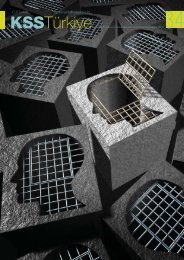You also want an ePaper? Increase the reach of your titles
YUMPU automatically turns print PDFs into web optimized ePapers that Google loves.
“Coming Soon: Free tools and data for<br />
heat network planning”<br />
Joshua Thumim, Head of<br />
Research at the Centre for<br />
Sustainable Energy in Bristol,<br />
introduces a new initiative<br />
designed to dramatically reduce<br />
the cost of planning local heat<br />
networks in Europe.<br />
Planning a local heat network is<br />
an expensive and complex business. This is hardly surprising,<br />
since district heating schemes are place-specific systems<br />
designed for the individual neighbourhoods they serve. There’s<br />
no off-the-shelf option.<br />
The networks themselves are conceptually straightforward; the<br />
top-level decisions are where the heat supply will be located<br />
and which buildings will be connected, and what is the most<br />
technically and economically efficient route to join the two.<br />
In practice however, and even in a relatively small<br />
neighbourhood, these choices can combine to produce a<br />
mind-boggling number of possibilities of which only a fraction<br />
are likely to be viable. And that’s assuming that you have good<br />
information on factors such as local heat demand and the likely<br />
cost of digging up the roads, but also the ability to use that<br />
information to model the techno-economic performance of a<br />
proposed network.<br />
So the challenge can be framed as a ‘search problem’: out of<br />
the hundreds of possible heat networks that you could build<br />
in a particular area, which is the best? Which buildings should<br />
be included, where should the energy centre go, how should<br />
we route the pipes that connect them, and – something often<br />
forgotten by planners – what does all this mean in practice for<br />
the occupants of the buildings being connected?<br />
The first step is to identify a small number of sensible<br />
candidates from the large set of possible networks. This is<br />
known as pre-feasibilty work. Once complete, more detailed<br />
analysis is undertaken to refine the list and identify a preferred<br />
option. This is known as feasibilty work, and only once this stage<br />
is fulfilled can full engineering design work be undertaken.<br />
The pre-feasibility stage is of critical importance, since it is here<br />
that potential solutions are identified or ruled out. However,<br />
public authorities often lack the tools and capacity to do this<br />
themselves, so typically commission this work from a limited<br />
number of consultancies who tend to undertake it more or less<br />
‘manually’ – for example, selecting areas of high spatial heat<br />
demand density from heat demand maps, and then looking<br />
for potential network solutions within these areas using various<br />
rules of thumb.<br />
This process is expensive, inefficient and slow, and does not<br />
tend to build capacity within the public authorities. It also fails<br />
to consider the full range of possible networks in a given area.<br />
What if it didn’t have to be like this? What if the energy system<br />
maps, software and modelling tools for identifing the best<br />
heat-network options were freely available to local authorities,<br />
energy companies and other agencies?<br />
We believe that this would reduce planning costs and<br />
development time, and bring the benefits of heat networks<br />
to more people, sooner. And this is exactly what THERMOS is<br />
attempting to do.<br />
Thermal Energy Resource Modelling and Optimisation System<br />
is a £3m EC Horizon 2020 funded research project which<br />
will provide the methods, data, and tools to enable public<br />
authorities and other stakeholders to undertake sophisticated<br />
thermal energy system planning far more rapidly and cheaply<br />
than they can today.<br />
In a nutshell, THERMOS aims to make local heat networks<br />
cheaper to develop by providing high resolution energy system<br />
maps, free software for identifying viable heat networks, and<br />
perhaps most importantly, sharing experiences between city<br />
energy planners, during and after the development of these<br />
tools.<br />
Of course, this won’t make the actual building of district<br />
heating networks cheaper or quicker, but it should dramatically<br />
accelerate the pace and reduce the cost of identifying the most<br />
promising networks in a given area, and help ensure that the<br />
systems that do go ahead are the right ones.<br />
What THERMOS offers<br />
Specifically, THERMOS will:<br />
• Develop and publish a state-of-the-art methodology for<br />
developing address-level energy system maps, to enable<br />
public authorities and other stakeholders to efficiently<br />
(and in some cases more rapidly) plan for the upgrading,<br />
refurbishment and expansion of existing heating and<br />
cooling network systems in any given area.<br />
• Produce a set of such maps for a series of four ‘pilot cities’<br />
(the local authority areas of Islington borough council in<br />
London in the United Kingdom, Warsaw in Poland, Jelgava in<br />
Latvia and Granollers in Spain.<br />
• Develop and publish models for analysing these maps to<br />
answer a range of questions required for thermal energy<br />
system planning by city, regional and national stakeholders.<br />
• Incorporate these models in a free, open-source software<br />
application tailored to the specific needs of different pilot<br />
city stakeholders.<br />
• Work closely with energy planning stakeholders to support<br />
the use of the new tools in real-world energy planning.<br />
• Support the implementation of the energy system mapping<br />
methodology, and subsequently the use of the software, in<br />
a further four ‘replication’ cities or regions (specifically Cascais<br />
in Portugal, Alba Iulia in Romania, Berlin and London).<br />
During and beyond the three-year lifetime of the programme<br />
itself, THERMOS will engage in a wider programme of<br />
dissemination and communication to maximise the impacts<br />
of the project. And after 2019, our hope is that we will leave a<br />
legacy through open-sourcing the methods data and tools, so<br />
that the benefits are spread far and wide.<br />
The four pilot cities were chosen because of their potential to<br />
plan and design a real-world system using the THERMOS tool.<br />
Each has different levels of experience and know-how with<br />
planning district heating. Between them, our pilot cities have<br />
a deep well of knowledge of the challenges facing thermal<br />
network planners. We’ll be using this to develop software that<br />
builds on real-world experience, and helps us understand<br />
what best-practice looks like - and how it can be replicated<br />
elsewhere.<br />
The four replication cities involved in the project – Cascais, Alba<br />
Iulia, Berlin and London - all have the desire and potential to<br />
expand, modernise or re-introduce<br />
They’ll play a crucial role in road-testing the THERMOS planning<br />
methodology and software to identify optimum areas for new<br />
networks and the best ways to refurbish existing ones. The<br />
replication cities will ensure that the tools THERMOS develops<br />
are fit-for-purpose and work to support real-world energy<br />
planning processes.<br />
And after that, the THERMOS resources will become available<br />
for everyone to use.<br />
Our plan is for local authorities and others to access the tools<br />
and data through an online software application which is<br />
simple to use, but which also reflects the detailed models<br />
required to underpin local network planning - an interesting<br />
design challenge in itself!<br />
At the moment the software is under development,<br />
progressing well in the capable hands of our software team<br />
here at CSE in Bristol, with the all important energy system<br />
modelling algorithms being created by THERMOS partner<br />
Imperial College London.<br />
We think THERMOS could be the key to unlocking the huge<br />
potential of district heating and cooling networks, and if we do<br />
our job well, many more parts of the UK and Europe will be in<br />
a position to benefit from an energy system which offers the<br />
much-needed low carbon and low cost energy supplies of the<br />
future.<br />
THERMOS CITIES<br />
Pilot City Replication City<br />
Granollers, Spain Cascais, Portugal<br />
Islington, UK London (GLA), UK<br />
Jelgava, Latvia Alba Iulia, Romania<br />
Warsaw, Poland Berlin (dena), Germany<br />
Working with CSE on THERMOS<br />
Our partners include universities, local authorities and city-wide<br />
authorities, energy and environmental agencies and specialist<br />
consultants:<br />
UK: Imperial College, London, Greater London Authority,<br />
London Borough of Islington; Spain: Creara Consultores<br />
SL, Ajuntament de Granollers; Poland: Krajowa Agencja<br />
Poszanowania Energii SA, Miasto Stoleczne Warszawa;<br />
Latvia: Vides Investiciju Fonds SIA; Jelgavas Dome; Denmark:<br />
Aalborg Universitet; Germany: ICLEI European Secretariat<br />
GMBH, Deutsche Energie-Agentur GMBH; Romania: Primaria<br />
Municipiului Alba Iulia; Portugal: Municipio de Cascais<br />
36<br />
37




